EBSA Status Assessment and Management Recommendations
Ecological Condition, Threat Status, Current Protection and Key Features in the EBSA
Relevant Pressures and Activities (impact, extent) | Management Interventions Needed for the EBSA
Activity Evaluation Per Zone: Zoning Feasibility | Research Needs & Future Process
Back to the Namibian EBSA status and management home page

Orange Cone is underpinned by land-sea connectivity through the Orange River. Huge volumes of sediment and freshwater are exported offshore, driving muddy ecosystem and associated communities, with conditions supporting important life-history stages of fish, as well as threatened top predators and ecosystems. The estuary supports a rich diversity and is a Ramsar site and Important Bird and Biodiversity Area for birds.
Click here for the full EBSA description
[Top]
Orange Cone is underpinned by a critical connection between land and sea via the Orange River that needs to be protected for the area to maintain the features and processes that give it its EBSA status. The criteria for which this EBSA ranks highly are: uniqueness and rarity, importance for life history stages, and importance for threatened species and habitats. There are 16 ecosystem types represented, most of which are muddy or sandy, and 10 of which are threatened. This area, including the estuary, is important for supporting key life-history stages of fish, and is also an important site for threatened fish, sharks and birds. In fact, the estuary area is an Important Bird and Biodiversity Area and a Ramsar Site. Kelp forests also contribute to the nursery function of the EBSA and are sensitive to disturbance.
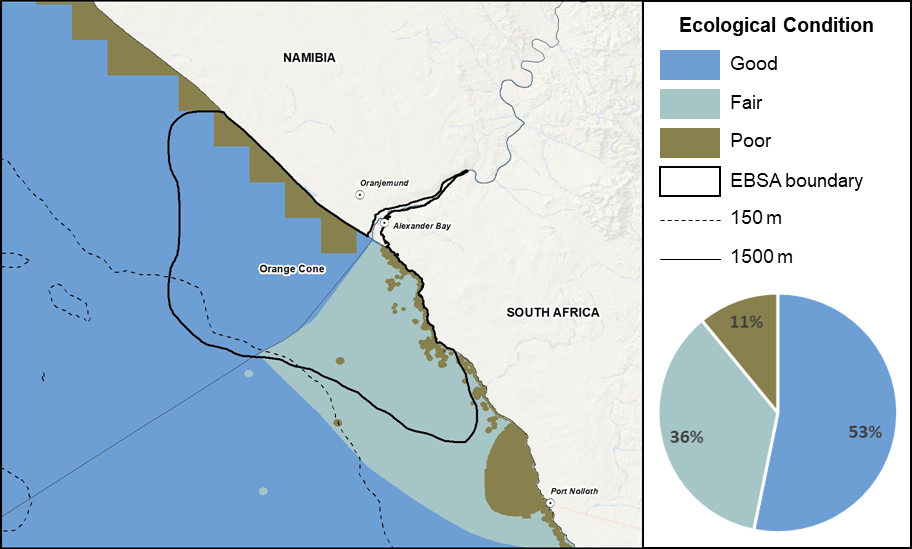
Orange Cone proportion of area in each ecological condition category.
Orange Cone is mostly in good ecological condition (53%), with notable portion that is fair (36%), and a smaller area that is in poor ecological condition (11%) generally along the shore. Consequently, half of the EBSA (50%) is Least Concern. However, the inshore areas and full offshore extent of the South African portion of the EBSA are threatened, mostly comprising Endangered (39%) and Vulnerable (10%) ecosystem types, with Critically Endangered (1%) and Near Threatened (<1%) types as well.

Orange Cone proportion of area in each ecosystem threat status category.
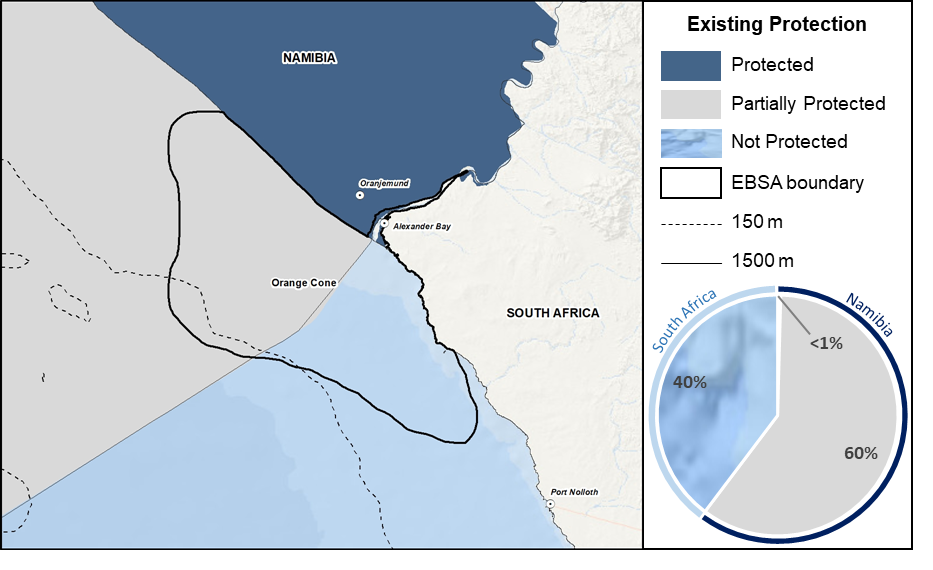
Orange Cone proportion of area in a Marine Protected Area (MPA).
The patterns in ecological condition and ecosystem threat status between the two countries are explained clearly by the stark contrast in protection and management between the two countries. On the Namibian side, there is land-sea protection, with the adjacent land being a protected area, and the coastal area falling within a reserve offering partial protection. In South Africa, there is no protection within the EBSA; this is one of only two EBSAs in South Africa where this is the case. Importantly, the South African portion of Orange Cone includes three high-risk ecosystem types, assessed as Endangered and not protected that are priorities for protection. Note that adjacent to the EBSA, there are also two terrestrial ecosystem types that are high risk, calling for land-sea coastal protection in this area if these ecosystem types and associated biodiversity are to be protected into the future. This cluster of five high-risk types comprises more than a third of the 13 high-risk coastal (terrestrial, estuarine and marine) ecosystem types in South Africa, as assessed in the National Biodiversity Assessment 2018.
Threat status, protection level and ecological condition of ecosystem types in the EBSA. Other key features are also listed.
|
Feature
|
Threat Status
|
Protection Level
|
Condition (%)
|
|
Good
|
Fair
|
Poor
|
|
Ecosystem Types
|
|
Namaqua Estuarine Shore
|
LC
|
MP
|
100.0
|
0.0
|
0.0
|
|
Namaqua Inner Shelf
|
LC
|
MP
|
97.0
|
0.0
|
3.0
|
|
Namaqua Inshore
|
VU
|
WP
|
45.6
|
0.0
|
54.4
|
|
Namaqua Intermediate Sandy Beach
|
CR
|
WP
|
9.5
|
0.0
|
90.5
|
|
Namaqua Reflective Sandy Beach
|
CR
|
WP
|
0.0
|
0.0
|
100.0
|
|
Cool Temperate Large Fluvially Dominated Estuary
|
EN
|
NP
|
95.4
|
1.8
|
2.8
|
|
Namaqua Exposed Rocky Shore
|
VU
|
MP
|
0.4
|
15.6
|
84.0
|
|
Namaqua Kelp Forest
|
VU
|
MP
|
0.1
|
33.8
|
66.1
|
|
Namaqua Mixed Shore
|
VU
|
MP
|
3.9
|
10.0
|
86.2
|
|
Namaqua Sandy Mid Shelf
|
LC
|
PP
|
99.8
|
0.2
|
0.0
|
|
Orange Cone Inner Shelf Mud Reef Mosaic
|
EN
|
NP
|
0.0
|
77.9
|
22.1
|
|
Orange Cone Muddy Mid Shelf
|
EN
|
NP
|
0.5
|
98.7
|
0.8
|
|
Southern Benguela Dissipative Intermediate Sandy Shore
|
LC
|
WP
|
3.1
|
86.0
|
10.8
|
|
Southern Benguela Dissipative Sandy Shore
|
LC
|
WP
|
1.6
|
97.1
|
1.3
|
|
Southern Benguela Intermediate Sandy Shore
|
NT
|
PP
|
2.5
|
91.4
|
6.1
|
|
Southern Benguela Reflective Sandy Shore
|
EN
|
MP
|
0.0
|
95.4
|
4.6
|
|
Other Features
|
-
Important Bird and Biodiversity Area
-
Ramsar site
-
Threatened fish (such as kob), sharks (such as Rostroraja albai and Mustelus mustelus) and birds (e.g., Damara Terns, Ludwig’s bustard, and breeding Cape Cormorants)
|
[Top]
The proposed zonation and recommended management in transboundary EBSAs is split at the national borders, with each country responsible for EBSA management in their own jurisdiction only. The sections below present the proposed management of Namibia's portion of this EBSA.
-
Between the two countries, there are eight pressures present in this EBSA, of which shipping and mining (largely for diamonds) are the only ones that occur on both sides of the border.
-
Pressures on the Namibian side include: coastal development, mining, shipping and lobster harvesting. Note that mean annual runoff reduction is included in the South African assessment and would also be an issue in the Namibian portion of the EBSA, but it was not included in that analysis given limited data availability at the time of assessment.
-
Key pressures in this EBSA that most directly impact the features for which the EBSA is described include: mean annual runoff reduction, mining, and coastal development. These activities, and activities upstream of the estuary (to limit impacts of flow reduction caused by, e.g., damming and abstraction), will need to be managed particularly well in order to protect the estuarine habitat for associated birds, and offshore ecosystem types, nursery habitats, and fish assemblages for which this EBSA is recognised.
-
Activities that are present in Namibia but do not take place in the EBSA include: ammunition and other dumping, benthic longlining, boat-based linefishing, boat-based recreational fishing, bottom trawling (general, freezer, wet), channel dredging, crab harvesting, dredge-spoil dumping, midwater trawling (horse mackerel), pelagic longlining, ports, port anchorage areas, salt pans, shipping refuge (disabled ships), shore-based fishing, and small pelagics fishing.
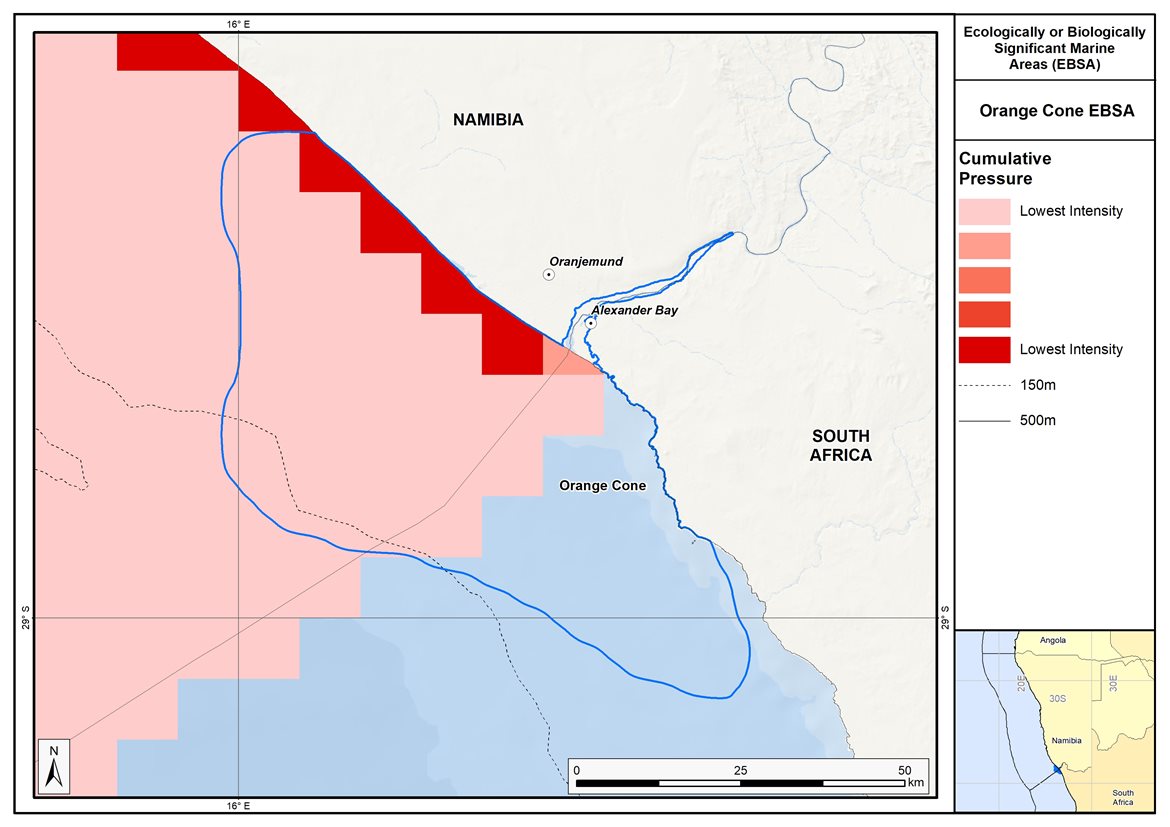
Map of cumulative pressure from all activities in the EBSA and surrounds. Darker reds indicate higher pressure intensity.
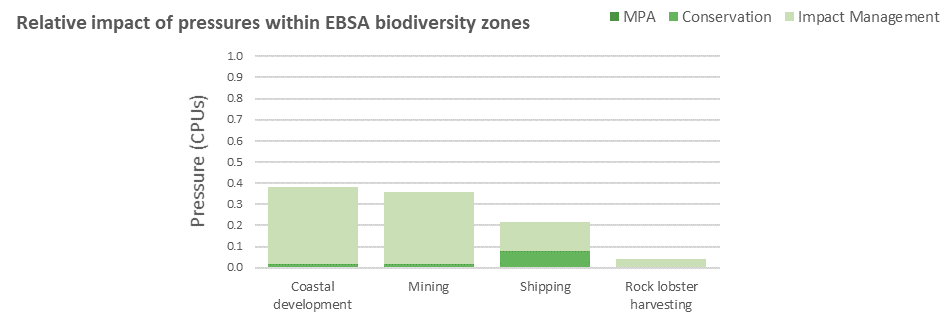
Pressure (in arbitrary cumulative pressure units, CPUs) summed for each pressure in the EBSA, per proposed EBSA biodiversity zone, ranked left (highest) to right (lowest) by the overall relative importance of pressures in this EBSA.
[Top]
Improved place-based protection of EBSA features should be pursued. In support of this, the EBSA is divided into a Conservation Zone and an Impact Management Zone, both comprising several areas within the EBSA. The aim of the Conservation Zone is to secure core areas of key biodiversity features in natural / near-natural ecological condition. Strict place-based biodiversity conservation is thus directed at securing key biodiversity features in a natural or semi-natural state, or as near to this state as possible. Activities or uses that have significant biodiversity impacts should be prohibited. Where possible and appropriate these areas should be considered for formal protection e.g., Marine Protected Areas or other effective area-based conservation measures (OECM). The aim of the Impact Management Zone is to manage negative impacts on key biodiversity features where strict place-based measures are not practical or not essential. In this zone, the focus is management of impacts on key biodiversity features in a mixed-use area, with the objective to keep biodiversity features in at least a functional state. Activities or uses which have significant biodiversity impacts should be strictly controlled and/or regulated. Within this zone, there should be no increase in the intensity of use or the extent of the footprint of activities that have significant biodiversity impacts. Where possible, biodiversity impacts should be reduced.
As far as possible, the Conservation Zone was designed deliberately to avoid conflicts with existing activities. On the Namibian side of Orange Cone, the adjacent land (outside the EBSA extent) is protected in the Sperrgebiet National Park (https://laws.parliament.na/cms_documents/sperrgebiet-delimitation-c2f73655a5.pdf). Shallow water areas adjacent to this reserve are partially protected by ‘shallow water trawling exclusion area’ regulations (Paterson and Kainge, 2014). However, no MPAs exist within this EBSA.
Proposed zonation of the EBSA into Conservation (medium green) and Impact Management (light green) Zones. MPAs are overlaid in orange outlines, with the extent within the EBSA given in dark green. Click on each of the zones to view the proposed management recommendations.
[Top]
Protection of features in the rest of the Conservation Zone may require additional Marine Protected Area declaration/expansion. Other effective conservation measures should also be applied via Marine Spatial Planning to ensure that the existing activities/uses are appropriately controlled to ensure compatibility of activities with the environmental requirements for achieving the management objectives of the EBSA Conservation and Impact Management Zones. Further, no new pressures should be extended into the Conservation Zone, even if they currently occur in the Impact Management Zone of the EBSA.
Recommended compatibility (consent1 or prohibited2) of activities currently present in the EBSA3 in the Conservation and Impact Management Zones
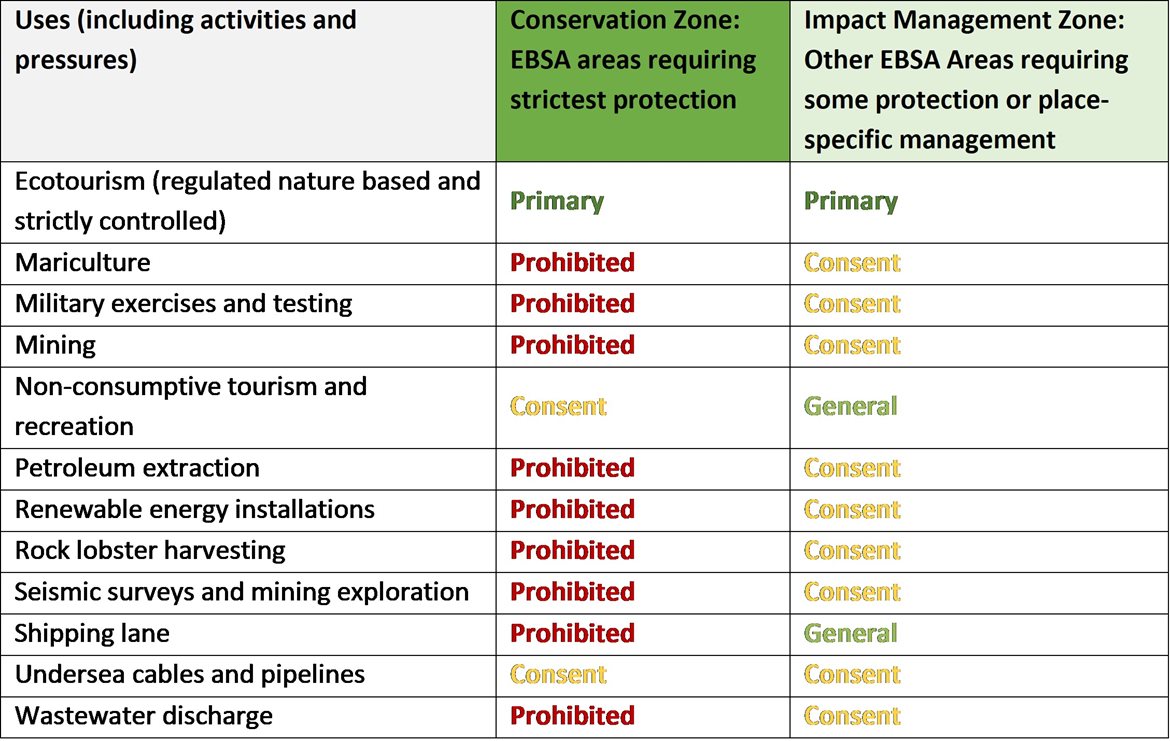
2Prohibited: An activity which is not allowed or should not be allowed because it is incompatible with maintaining the biodiversity objectives of the zone.1Consent: An activity which can continue in this zone subject to specific regulation and control.
3Note that activities present in South Africa that are not relevant to the EBSA have been excluded from the table (e.g., the harvested species does not occur in the area; or the industry operates at a depth outside the depth range of the EBSA).
Furthermore, no new activities that can negatively impact the environment should be allowed in the EBSA, and some activities present in the EBSA do not need to be managed by EBSA zoning and can continue as per the current regulations. There are also some pressures on biodiversity features within the EBSA that originate from activities outside of these EBSA or beyond the jurisdiction of MSP. In support of maintaining the ecological integrity of and benefits delivered by the key biodiversity features, these other activities need to be appropriately managed by complementary initiatives.
Recommendations for other activities outside the EBSA or the MSP management jurisdiction.


Proposed zonation of the EBSA, with the cumulative intensity footprint of activities within the EBSA (sorted highest to lowest) given relative to the national footprint of those activities to illustrate feasibility of management interventions.
The three most important pressures in this EBSA are mining (prospecting and mining), and lobster harvesting; all of which comprise only a small percentage of the national footprint of these activities. All three are present almost exclusively in the Impact Management Zone, and are listed as Consent activities, where they are recommended to continue as Consent activities. Other activities noted in the table of management recommendations above are either not currently present in the EBSA or are emerging activities; as far as possible, these are accommodated in the EBSA, depending on their compatibility with the management objectives of the two zones.
There are also several activities that are largely outside the EBSA but have downstream impacts to the biodiversity within the EBSA, e.g., from mean annual runoff reduction, coastal development, coastal disturbance, and wastewater discharge. The impacts should be managed, but principally fall outside the direct management and zoning of the EBSA. These existing activities are proposed as Consent activities for both EBSA zones, recognising that they should ideally be dealt with in complementary integrated coastal zone management in support of the EBSA. For example, investment in eradicating the alien invasive species could aid in improving the ecological condition of rocky and mixed shores, improving benefits for subsistence and recreational harvesting; and rehabilitation of degraded dunes and formalising access points could support improved habitat for nesting shorebirds, and enhanced benefits for coastal protection during storm surges. Similarly, improved estuary management through development of appropriate freshwater flow requirements, estuarine management plans and wastewater management regulations can improve the ecological condition of the surrounding marine environment, in turn, improving water quality and safe conditions for human recreation.
Research Needs
There are no specific research needs for this EBSA in addition to those for all EBSAs. However, it is noted that much more baseline research and ongoing monitoring is needed to ensure that the key features of the EBSA are well managed. Many issues link to the management of the Orange River Mouth, as well as diamond mining along the coast and in marine areas of both countries. Other research into the fluvial fan and plume is also recommended to better understand land-sea connectivity processes, and the effect that freshwater flow reduction could have on marine systems.
Future Process
There needs to be full operationalisation and practical implementation of the proposed zoning in South Africa and Namibia’s national marine spatial plans, with gazetted management regulations following the proposed management recommendations outlined above. MPA declaration within the EBSA should be explored, with relevant areas included into focus areas that can be considered further in a dedicated MPA expansion process with adequate and meaningful stakeholder engagement. If MPA declaration is not possible, then other formal protection measures should be considered, e.g., OECMs, to ensure that the features for which the EBSA was described are adequately protected. Further alignment between land-based and marine biodiversity priorities should also be strengthened, e.g., through the cross-realm planning in the CoastWise project. Regional alignment through the BCC should continue, which could also facilitate exploration of transboundary MPAs.
[Top]